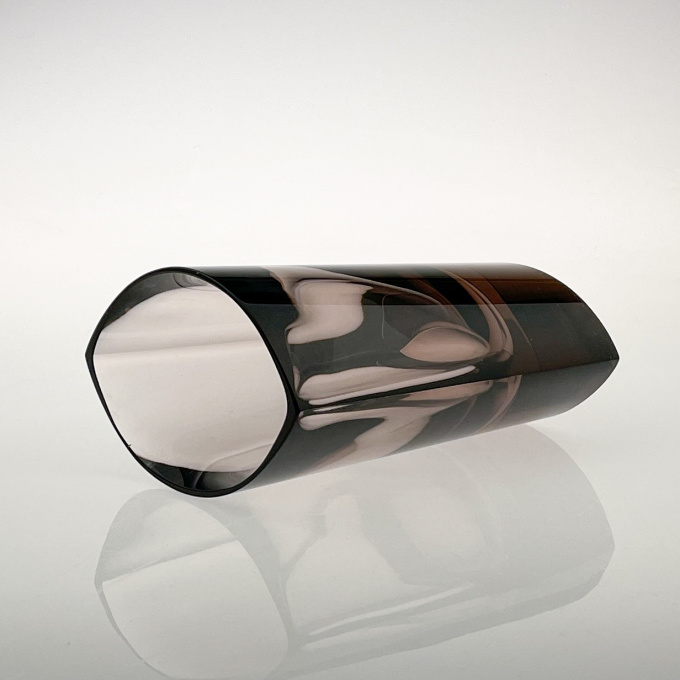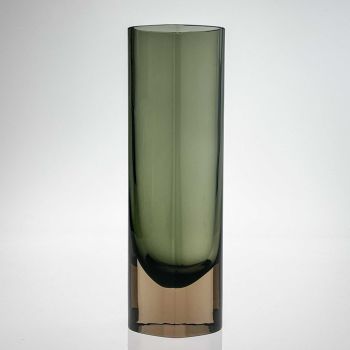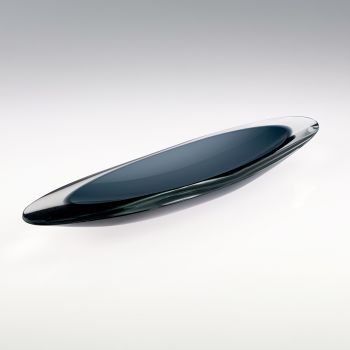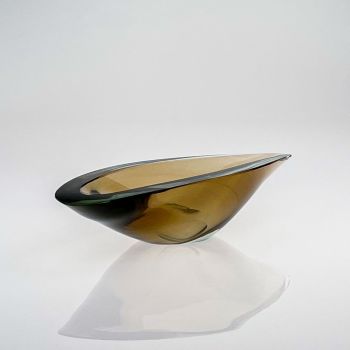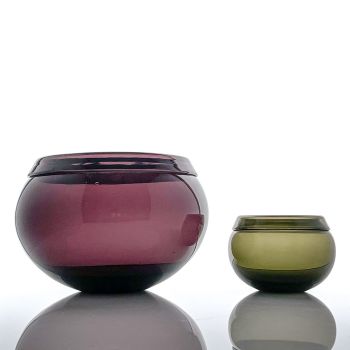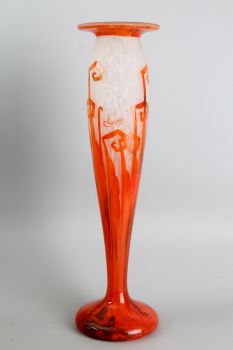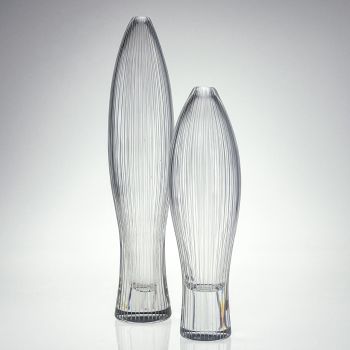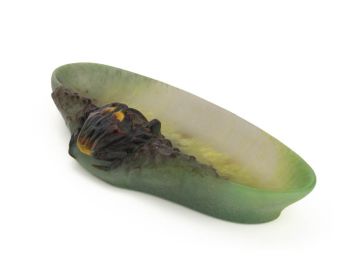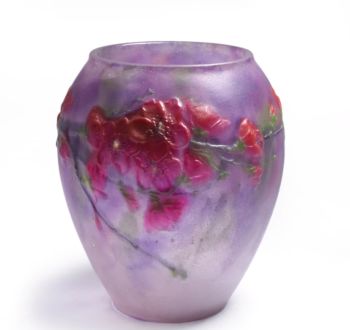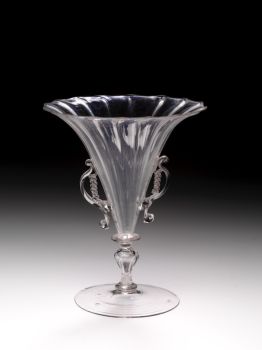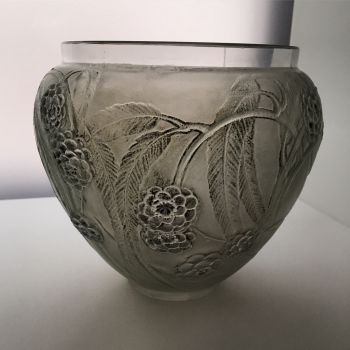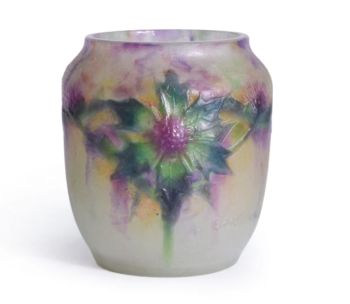A Scandinavian Modern pink art glass object / vase, model N 407 – Nuutajärvi-Notsjö, Finland 1967 1967
Kaj Franck
Bicchiere
20 ⨯ 16 ⨯ 7 cm
ConditionVery good
€ 800
Van Kerkhoff Art
- A proposito di opere d'arteA fixed mould-blown, cut and polished pink glass Art-object, model N407. Designed by Kaj Franck in 1967 and executed by the Nuutajärvi-Notsjö glassworks in that same year.
These art-objects were only made in 1967 in one size and two colours – green and pink – and are therefore quite rare.
It is marked underneath the base: Nuutajärvi-Notsjö. In accordance with Kaj Franck’s ideas regarding the role of the artist in the creative process, his designs were – from mid-1960’s to the late 1960’s – signed with the factory name only.
About Kaj Franck
Kaj Franck (Vyborg, Finland 1911 – Santorini, Greece 1989), a pioneering Finnish designer and a prominent figure in the Finnish art world from 1940 to 1980, left an indelible mark on the design landscape. Today, his name is synonymous with excellence and innovation, as exemplified by the prestigious “The Kaj Franck Design Prize,” which is annually awarded by the esteemed Finnish Design Forum.
Born in 1911 on the Finnish-Russian border into a family with a rich architectural heritage, Franck had design in his blood. His grandfather held a prominent position as the director of the renowned Arabia Ceramics factory, underscoring the influence and inspiration that surrounded him from an early age.
Franck pursued his passion for design by studying at the furniture department of Taideteollinen korkeakoulu, known today as the Aalto University School of Arts, Design, and Architecture, in Helsinki. Equipped with a solid foundation in design principles, he embarked on a career as a freelance designer before joining Arabia in 1945. It was during his time at Arabia that Franck’s talent truly flourished, and in 1950, he assumed the role of the company’s Artistic Director.
While his contributions to Arabia were significant, Franck’s creative vision extended beyond ceramics. He also designed glass objects for Iittala between 1946 and 1950, and later for Nuutajärvi-Notsjö glassworks from 1950 to 1976. His designs, particularly in everyday tableware and glassware, propelled him to the forefront of the design world. Notably, his iconic Kilta tableware and Kartio glassware are celebrated as revolutionary and enduring symbols of classic Finnish design.
Franck’s design philosophy embodied a profound commitment to principles of moderation, ecology, and equality. Often referred to as “the conscience of Finnish design,” he advocated for minimalism and the conscious reduction of everyday objects, emphasizing the importance of sustainability and product life cycles. Franck’s designs were a testament to his belief that beauty and functionality could coexist harmoniously, enhancing the lives of individuals while respecting the environment.
Recognized for his exceptional contributions, Franck’s works grace the collections of esteemed museums worldwide. Noteworthy institutions such as the Design Museum Helsinki, the Museum of Modern Art in New York, the Stedelijk Museum Amsterdam, and The British Museum in London all proudly display his creations. Throughout his illustrious career, Franck received numerous accolades, including the prestigious Lunning Prize in 1955, as well as “Grand Prix” and multiple “Gold Medals” at the renowned Triennale di Milano.
Kaj Franck’s enduring legacy rests not only on his remarkable designs but also on his unwavering commitment to advancing the field of design. His vision, which emphasized sustainability, simplicity, and social consciousness, continues to inspire designers and enthusiasts alike, ensuring that his influence will be felt for generations to come.
Marked
signed underneath the base in diamondpen: Nuutajärvi-Notsjö
Condition
This art-object is in good vintage condition, some minor scratches and wear consistent with age and use. No chips or cracks.
Literature
Marianne Aav (ed.), Kaj Franck, Universal Forms, p.329
Dimensions
Height 20 cm
Width 16 cm
Depth 7 cm
Weight 2500 grams - A proposito di opere artista
Il designer finlandese di ceramica e vetro Kaj Franck (1911-1989) ha realizzato una potente verità nella sua illustre carriera: semplice è bello. Nonostante il mondo si muova a un ritmo sempre più veloce, da un decennio all'altro, quella semplice verità rimane. L'ispirazione ei principi di Franck hanno dato inizio a una tradizione nel design finlandese, che è ancora viva e forte oggi. Le sue opere più note sono Iittala Teema e la serie Kartio, e la sua eredità fa parte di ogni casa finlandese.
"Voglio fare uso di oggetti che sono così ovvi da non essere evidenti", Kaj Franck ha definito il proprio lavoro. I suoi progetti soddisfacevano i bisogni umani di base mentre servivano loro strumenti con proprietà di oggetti di uso quotidiano. Franck era anche interessato a basso- costò la produzione di massa e rifiutò il materialismo, la cultura dell'usa e getta e l'ostentazione. Il mondo di Franck consisteva nelle forme matematiche di base e nelle forme semplici, decorate solo con colori forti.
Il punto di partenza del lavoro di Franck era la praticità unita alla bellezza. Anche se oggi sembra ovvio, ai suoi tempi i suoi pensieri erano radicali. Franck ha separato gli stili e le tendenze della moda dalla tradizione e gli ha dato un significato completamente nuovo. Nel periodo 1952-53, Franck ha dimostrato che le stoviglie non devono essere eccessivamente complesse con l'uscita della serie Kilta come affermazione forte: era un'idea nuova che ognuno fosse in grado di apparecchiare la tavola secondo le proprie esigenze .
Franck ha iniziato i suoi progetti concentrandosi sull'idea o sul concetto sottostante, non sulla forma. Questa enfasi sull'aspetto ideativo del design è stata trasferita anche al suo lavoro come insegnante e successivamente come direttore artistico presso l'Università di Arte e Design di Helsinki. Franck è stato anche uno dei primi sostenitori del riciclaggio ed è stato spesso definito la "coscienza del design finlandese". Franck ha vinto numerosi premi nella sua illustre carriera ed è diventato famoso a livello internazionale. Oggi, il Kaj Franck Award è il riconoscimento di design più prestigioso della Finlandia .
Sei interessato ad acquistare questa opera d'arte?
Artwork details
Related artworks
- 1 - 4 / 9
Børge Mogensen
Teak wood “dropleaf” desk – Søborg Møbler, Denmark circa 19551950 - 1960
Preis auf AnfrageVan Kerkhoff Art
1 - 4 / 24Gabriel Argy-Rousseau
Gabriël Argy-Rousseau – Crabes et Algues vase – 19201920 - 1929
Preis auf AnfrageAntiques Emporium
Amalric Walter
Amalric Walter & Henri Bergé – Crabe plumier1920 - 1929
Preis auf AnfrageAntiques Emporium
1 - 4 / 24Herman Bogman jr.
Flower still life of a nasturtium in a blue vase1950 - 1965
Preis auf AnfrageAdelwein Kunst
Johann Loetz (Lötz) Witwe Klostermühle
Johann Loetz Witwe - Phänomen Genre 7773 – Orange1900 - 1910
Preis auf AnfrageAntiques Emporium
Unbekannter Künstler
François-Théodore Legras – Tall “Fleurs de Pommier” apple blossoms vase1900 - 1909
Preis auf AnfrageAntiques Emporium
René Lalique
Eine sehr seltene tiefgrüne Fougeres-Vase, entworfen von R. Lalique1912
€ 8.950Lennart Booij Fine Art and Rare Items
 Kuratiert von
Kuratiert vonSilla Scheepens
Unbekannter Künstler
Japanese art deco lacquervase with Scarab beetle motif1920 - 1950
Preis auf AnfrageDille Art
1 - 4 / 24Gabriel Argy-Rousseau
Gabriël Argy-Rousseau – Crabes et Algues vase – 19201920 - 1929
Preis auf AnfrageAntiques Emporium
Unbekannter Künstler
Venezianisches geflügeltes Glas1550 - 1599
Preis auf AnfragePeter Korf de Gidts - Antiquairs
1 - 4 / 24- 1 - 4 / 12





